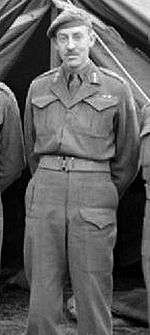Daniel Spry
Major General Daniel Charles Spry CBE DSO CD (February 4, 1913 – April 2, 1989) was a senior Canadian Army officer who commanded the 3rd Canadian Infantry Division during Operation Veritable in World War II.[1]
Daniel Charles Spry | |
|---|---|
 | |
| Born | February 4, 1913 Winnipeg, Manitoba, Canada |
| Died | April 2, 1989 (aged 76) Ottawa, Ontario, Canada |
| Buried | Beechwood Cemetery, Ottawa, Ontario, Canada |
| Allegiance | |
| Service/ | |
| Years of service | 1932–1946 |
| Rank | Major General |
| Unit | The Royal Canadian Regiment |
| Commands held | 1st Battalion, The Royal Canadian Regiment 1st Canadian Infantry Brigade 11th Canadian Infantry Brigade 3rd Canadian Infantry Division |
| Battles/wars | Sicily Italy Normandy Boulogne Scheldt Rhineland |
| Awards | Commander of the Order of the British Empire Distinguished Service Order Canadian Forces Decoration |
| Other work | Chief Executive Commissioner of the Scout Movement in Canada |
War service
In 1943, Spry commanded the 1st Battalion, The Royal Canadian Regiment and then the 1st Canadian Infantry Brigade, in Italy. In 1944, he commanded the 12th Canadian Infantry Brigade. Later, in 1944, he took charge of the 3rd Canadian Division, in northwest Europe, until the end of the Rhineland Campaign.[2] The commander of II Canadian Corps, Guy Simonds, was dissatisfied with Spry's performance during the assaults on heavily defended woodland near Moyland, southeast of Kleve and later on the Hochwald, saying that he "lacked quick tactical appreciation and robust drive in ... urgent tactical situations". In turn, Spry felt that neither Simonds nor Crerar fully understood the situation "at the sharp end of battle". Simonds was adamant that Spry should go but Crerar was more sympathetic and he campaigned for Spry's appointment to the Canadian Reinforcement Units in Britain, appreciating Spry's ability as a trainer of soldiers (endorsed by Simonds) and the value of having a battle experienced officer in that role.[3][4] Spry was relieved of command of the 3rd Division at the end of Operation Blockbuster and he duly left for Britain to command the Canadian Reinforcement Units.
Postwar
In 1946, Spry became Vice-Chief of the General Staff at National Defence HQ in Ottawa[1] and retired later that year.[2]
In 1969, Spry presented the Major-General D.C. Spry Trophy, an annual small arms competition for The Royal Canadian Regiment.[5]
Scouting
Spry became Director of the Boy Scouts World Bureau and was awarded the Bronze Wolf, the only distinction of the World Organization of the Scout Movement, awarded by the World Scout Committee for exceptional services to world Scouting, in 1961.[6] In 1956 he also received the highest distinction of the Scout Association of Japan, the Golden Pheasant Award.[7]
| World Organization of the Scout Movement | ||
|---|---|---|
| Preceded by J. S. Wilson |
Secretary General 1951–1965 |
Succeeded by Richard T. Lund |
References
- "Major-General D.C. Spry". Canada in WWII. Retrieved June 1, 2009.
- Ammentorp, Steen (2000–2009). "Major-General D.C. Spry". Canadian Generals. generals.dk. Retrieved June 1, 2009.
- Dickson, Paul Douglas (2007). A thoroughly Canadian general. University of Toronto Press. ISBN 9780802008022. Retrieved June 3, 2009.
- Copp, J. T.; Richard Nielsen (1996). No price too high: Canadians and the Second World War. McGraw-Hill Ryerson. ISBN 9780075527138. Retrieved June 3, 2009.
- "The Major-General D.C. Spry Trophy". Royal Canadian Regiment. 2009. Retrieved June 1, 2009.
- John S. Wilson (1959), Scouting Round the World. First edition, Blandford Press. p. 133, 190, 194, 218, 219, 239, 256, 262, 266, 271, 276, 281
- reinanzaka-sc.o.oo7.jp/kiroku/documents/20140523-3-kiji-list.pdf